Johnny Gonzales Makes A Statement
Posted: Tuesday, September 19, 2000
By: Darren Schroeder
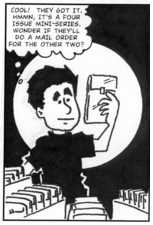
Johnny "El Santo Negro" Gonzales is described by Collector Times Online as an active duty Air Force member stationed in the middle of nowhere. He lives with his wonderful wife of ten years, Judy, their two children, and three pets. When not eating pizza for breakfast, lunch, and dinner and watching professional wrestling on TV, Johnny likes to break out a pad of paper and his trusty Sharpy markers and create great works of sequential art. Johnny responded to The Small Press Fan's questions and we are following those up with a few of our own.
SPF: How long have you been interested in drawing and/or writing?
Johnny Gonzales: Since I first picked up a pencil, probably around 5 or 6.
SPF: Did you do well in art classes (or english for writers) while you were attending school?
JG: I didn't take my first art class until I was 23 and took a couple of courses at the local 2 year college in my town. I did ok but became disillusioned by what I felt was a "lack of"teaching by the instructor.
SPF: Were you encouraged to pursue your interest in art or writing by anyone when you were young?
JG: My 10th grade American history teacher introduced me to the "writers and artists market" but it wasn't until I met my wife that anyone really encouraged me to learn more about art.
SPF: How old were you when you read your first comic book?
JG: I was probably 8 and it was a spider-man comic in which he took on the molten man.
SPF: Were you a regular comic book reader as a child?
JG: Whenever my mother could afford to buy me one of those expensive 25 cent buggers.
SPF: What non-comic book art forms were you exposed to as a child?
JG: In elementary we visited a couple of museums as well as the symphony but that was about it.
SPF: Who or what would you say have been the major influences on your art or writing?
JG: When I was in high school it was comic book artists such as George Perez, John Byrne, and Frank Miller.Nowadays, I try to pick up a little of everything from painters to editorial cartoonists to caricaturists
SPF: How did you first learn about small press?
JG: I was subscribing to The Aspiring Cartoonist newsletter (later renamed cartoonist and comic artist magazine)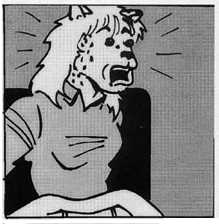 SPF: what was your first "official" small press comic called?
SPF: what was your first "official" small press comic called?
JG: Steel trap.Story about a high school math teacher who's fiancee is kidnapped.He solves the mystery, rescues her, and exposes the kidnapper.
SPF: How man comics or publications would you say you have contributed to or published to date?
JG: I've submitted to Bob Corby's Oh Comics issue #s 8 1/2, 9, 10, and 11,and Hallucination Studios Anthology Comics issue #s 2, 3, and 4.I've submission numerous spot illustrations to Bob Elinska's Small Press Feedback, and various pin-ups to Graystown Girls, and Malignant Strain.
SPF: What is your fondest small press related memory?
JG: Teaming up with Perry Lake to draw an issue of Cassipeia, The Witch.
SPF: Why do you create small press comics or publications?
JG: I guess because I have all these ideas in my head and want them committed to paper and have someone see them.
SPF: What small press co-ops or clubs do you belong to?
JG: SPS and UFO
SPF: What are your three favorite small press publications published by someone other than yourself?
JG: Cassiopeia, the Witch...Fantasy Theater...Malignant Strain...Steppenwolf Chronicles...Karpe's Kartoon Kornerand numerous others.
SPF: What three "pro" comic books do you read regularly?
JG: Savage Dragon, Kane, Kabuki
SPF: What is your work process when you create?
JG: For the story....brainstorm the idea; createthe beginning and ending, then work my way from one end to the other.
Drawing....thumbnail each page, pencil each specific panel, then trace it onto the final page and ink.
SPF: How much time are you able to devote to small press activities in a week?
JG: About 20 minutes a day
SPF: Where do you get your ideas or inspiration from?
JG: Mostly newspaper and tv news.
SPF: What are your long time plans or goals that you wish to accomplish in small press?
JG: Tell all the stories I can think up.
SPF: What are you working on now?
JG: Currently working on Steel Trap #4, Savage #2, and Starr Security Service with my collaborator, Floyd Choat.
Darren Schroeder: You said that your wife encouraged you to learn more about art. What does she think about your work in comics?
JG: My wife is very supportive of my work and likes it a lot. Whenever I get something published she is the first to go show it off to everyone at her job. She's glad that I do try to submit my work to many places and not just let it sit in my desk for any myriad of reasons.
She also says that I draw her "prettier" than she really is.
DS: Where did the idea for Steal Trap come from?
JG: Steel Trap came about when co-creator Larry Berlin and I were talking together at work and he was telling me about a novel he'd been writing off an on for many years. The story was about a high school math teacher that solves the kidnapping of his fiancee. When he's describing the main character, he says, "The guy has a mind like a steel trap" and that just stuck with me when he said it and it became the title of our comics.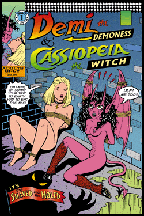 DS: Was your art for Cassipeia #37 your first adult comic work?
DS: Was your art for Cassipeia #37 your first adult comic work?
JG: Yes it was. However, when I first started trying to get my drawings published, I submitted dozens of cartoons to many adult magazines, two of which were published by Aja Blue Magazine.
DS: Did you have any concerns over doing an x rated comic?
JG: No, not really. I'm not working for any "major" companies right now and I think the "stigma" of drawing adult material is long gone. After all, when you have folks like Adam Hughes, Jason Pearson, Gray Morrow who have all done work for Penthouse Comics still doing work for Marvel and DC, it must be safe.
DS: Is you wife happy for you to be doing work like that?
JG: She doesn't mind. Of course she'd be happier if I was making a ton of money doing it so she could sit at home and watch TV all day and eat bon-bons.
DS: How do you distribute your comics?
JG: Right now, I mostly do trades with a large list of people I've met through the small press network. I also send out quite a few to industry professionals as well. I really wish there were comic conventions closer to where I live because I feel I could get my comics in the hands of more people this way.
DS: Where exactly are you?
JG: I live in a little hodunk-podunk town in Oklahoma called Altus. 55 miles to the nearest 1-story mall and 2 1/2 hours from a big city.
DS: What is the local small press scene like there?
JG: Here? Non-existant. Thank the good Lord for the internet and e-mail and co-ops like the BPP, UFO, and SPS which is a network of small pressers from all over.
DS: Are comic shop owners your favourite kind of people?
JG: Unfortunately, I have had nothing but BAD experiences with comic shops. I think in all my years in doing business with comic shop owners, only two were good. The incident I portrayed in Ten Ways to Lose a Customer in Bits -n- Pieces is a TRUE story and seems to be the norm. 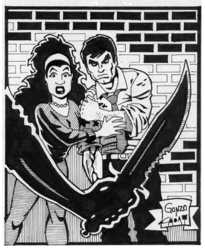 DS: What things do shop owners need to improve on?
DS: What things do shop owners need to improve on?
JG: Well, unfortunatley, what they are currently doing, pandering to the Pokemon craze and collector mentality is what they need to do to stay in business and make some kind of profit.
I don't expect them to know every single independent title, but I would at least appreciate it if they could at least pick up the damn Previews mag and do some quick research whenever I ask them about KANE or Jack Staff from Dancing Elephant Press, rather than just saying, "Never heard of it."
Other things I wish they would do - Set aside a comic they feel people would like for customers to read at their leisure. Heck, Ask the customers themselves if they would like to DONATE a comic that they think other people would be interested in reading.
Try to help regular customers find one another who are looking for certain books they themselves can't find. If Customer "A" needs Punisher #6 put up a note on a bulletin board for everyone to see and watch the networking begin.
As far as small press, support your local creators. Ask for several issues on consignment and put those books up right next to the cash register, they don't take up much room.
DS: What materials and equipment do you use when drawing your comics?
JG: Very basic stuff. Bond paper and sharpy markers. I do all my lettering with a computer using CorelDraw 3.0 and a free font I found on the internet.
DS: Describe the general themes of your current work.
JG: My current work with my often co-collaborator, Floyd Choat is noir-based. It's not grim and gritty like Frank Miller or David Lapham. It's more like Paul Grist's work on Kane. At the moment, we're doing a series of books that take place in a fictional city called Tooloose:
Starr Security Service is about a former stripper and her partner, a former wrestler, who now run this bodyguard service.
Shade is about a bounty-hunter.
Savage is about a former head of security for a major laboraty who is used as a guinea pig for an experimental serum. She escapes and is being hunted by the lab, however, the serum is starting to change her into something more than human.
Malcom Z is about another free-lance bodyguar (who works occasionally for Starr Security Service).
I.A.D. is about two detectives who work for the Internal Affairs Division of the Tooloose Police Department.
Steel Trap (which is not connected to these other stories) is about a high school math teacher to gets involved in a myriad of mysteries which he tries to solve.
No Way Out (which Starr Securty Service is a spin off of) is simply a "jam" comic which Floyd and I did as a way of just keeping our "creative juices" flowing.
DS: Have you ever wanted to firebomb a photocopy shop?
JG: My lawyer has advised me to plead the 5th on that one.
DS: If a film was made of your life, who should play you?
JG: Oh man who else, Antonio Banderas. He's almost as good looking as me, too!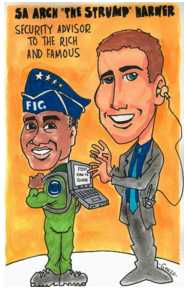 DS: What are the good points and the bad points of collaborating on a comic?
DS: What are the good points and the bad points of collaborating on a comic?
JG: Depending on who is doing what (writing, drawing, etc,) the good point is that you have someone else who can help brainstorm and bounce ideas off of. If the two of you click on this project, this person can really help make the final product look hundreds of times better than if you had worked on it yourself.
The downside is, if you work with someone who you are depending on to get something very important done, whether it be writing, drawing, inking, coloring etc., and this person suddenly pulls a houdini or becomes disinterested, then you can kiss this project goodbye.
DS: How often do you read comics while in the smallest room in the house?
JG: All the time. In fact, I wanted to put one of those comic racks you use to see in convenience stores next to the porcelain throne but my wife vetoed that idea.
DS:What makes a comic interest you?
JG: Artwork is important because that's what catches my attention when I'm able to pick up the book and browse through it (which many comic shops don't let you do).
However, if I do buy the book based on the artwork and once I take it home and read it, it fails to entertain me, then it's a sure bit I won't be picking up the next issue.
JG: Comics or the Air force, which does America need most?
JG: In a perfect world, COMICS! However, if it wasn't for the Air Force, I wouldn't have the moolah to buy them.
You can contact Johnny Gonzales via:
gonzoSTOP-@-SPAMintellisys.net
Related Links
Johnny's Web Site
Starr Security Service currently on-line at www.collectortimes.com
Some samples of Johnny's comics
More samples
Cassiopia preview
If you have a comment or question about Small Press then feel free to contact me